U.S. Department of Transportation
Federal Highway Administration
1200 New Jersey Avenue, SE
Washington, DC 20590
202-366-4000

U.S. Department of Transportation
Federal Highway Administration
View the PDF Version [816 KB]
In this issue:
Promotion of Countermeasures Proven to Increase Safety
Update on NHTSA Grants to Pedestrian Focus Cities and States
Update from National Center for Safe Routes to School
California Develops Innovative Programs to Improve Pedestrian Safety
FHWA Safety Office Hosts Webinar on HAWK/RRFB
Since 2004, FHWA's Safety Office has been working to aggressively reduce pedestrian deaths by focusing extra resources on the cities and states with the highest pedestrian fatalities and/or fatality rates. The states and cities were revised in late 2011 to what you currently see in the map shown. FHWA decided to go to more of a "cities" approach because pedestrian safety tends to be more of an urban problem, where a customized "local" approach would have a bigger impact than a "state" approach.
Cities were identified as pedestrian focus cities if they had more than 20 average annual pedestrian fatalities or a pedestrian fatality rate greater than 2.33 per 100,000 population (the annual national average number of pedestrian fatalities is 20 and the average national rate of pedestrian fatalities is 2.33 per 100,00 population). States with a focus city were automatically identified as focus states.
As mentioned in the Summer 2011 Pedestrian Forum Newsletter, and the Fall 2010 Pedestrian Forum Newsletter, FHWA has had measurable success with the focused approach, and hopes to continue that momentum by continuing to provide free technical assistance and training, but also by being more aggressive in gaining a commitment to pedestrian safety among stakeholders and in measuring progress through the establishment of a baseline assessment.
A Peer Exchange will be hosted in the spring with representatives from each city and state to kick-off the revamped pedestrian safety focus states and cities effort. FHWA will also continue putting on quarterly webinars through the Pedestrian and Bike Information Center, which is assisting with the technical assistance and training as a subcontractor to VHB.
In 2008, FHWA issued a "Guidance Memorandum on the Consideration and Implementation of Proven Safety Countermeasures" which highlights when and where FHWA believes certain safety countermeasures should be used. Many of the countermeasures promoted in 2008 have been widely applied and FHWA has updated its previous guidance. While agencies should still consider the application of all of the countermeasures listed in the 2008 memo, the 2012 "Guidance Memorandum on Promoting the Implementation of Proven Safety Countermeasures" supersedes that from four years ago and takes into consideration the latest safety research using a data-driven approach with countermeasure selection based on analytical techniques.
Safety practitioners are encouraged to consider this new set of countermeasures that are research-proven, but not widely applied on a national basis. There are three countermeasures aimed at increasing pedestrian safety, but all of them are proven to increase safety for all road users: Medians and Pedestrian Crossing Islands, Pedestrian Hybrid Beacon, and "Road Diets." Please visit FHWA's Proven Safety Countermeasures website to learn more about these countermeasures (and the other six as well) and how your state or locality can use them.
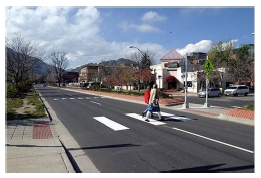 |
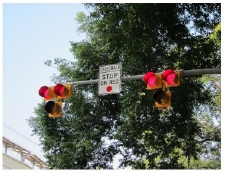 |
Proven Countermeasure: Medians
and Pedestrian Crossing Islands. |
Proven Countermeasure: Pedestrian Hybrid Beacon. |
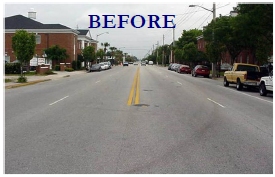 |
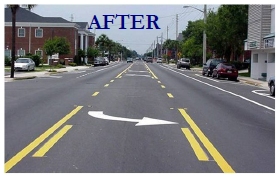 |
Proven Countermeasure: Road Diet (or Roadway Reconfiguration).
|
|
Submitted by Leah Walton
|
Bookmark www.walktoschool.org and prepare to switch gears to Bike to School Day this May. A new website will be unveiled in April with more information about Bike to School Day and new event planning resources and tools, including a new GIS powered walking and biking route mapping tool.
|
As discussed in the Fall 2009 Edition of this newsletter, the National Highway Traffic Safety Administration (NHTSA) awarded cooperative agreements to promote pedestrian safety education and enforcement programs to four Pedestrian Safety Focus Cities/Focus States—Chicago, Florida, North Carolina and New Mexico. Chicago and New Mexico have had some recent high level activity under the grant program.
Chicago: Over the last five years, Chicago has averaged over 50 pedestrian fatalities annually. However, there has been improvement in recent years with 34 and 32 pedestrian deaths in 2009 and 2010 respectively. Pedestrian fatalities in Chicago make up 31% of all State pedestrian fatalities.
During the summer months, Chicago implemented multiple pedestrian crosswalk enforcement operations at selected high pedestrian crash locations. Law enforcement issued citations to motorists for speeding in high pedestrian-density locations and motorists neglecting of yield to pedestrians, as well as pedestrian disregard of traffic control with oncoming traffic. The goal is to increase yielding behaviors of drivers and increase safe walking and crossing behaviors of pedestrians.
NHTSA Administrator David Strickland spoke at a press event on October 25th to unveil an awareness campaign directed at pedestrians and drivers. The campaign involves an installation of 32 mannequins along Wacker Drive, each representing one of the 32 pedestrians killed in Chicago crashes in 2010. The campaign also includes: awareness messages on street furniture (bus shelters, info panels, trash receptacles, etc.) and direct outreach to schools, senior facilities, and taxi drivers. CDOT will also install small crossing flags at key neighborhood locations, and stencil pedestrian safety messages on sidewalks in high traffic areas around the city.
New Mexico: In New Mexico, 39 pedestrians were killed in 2009. Pedestrian fatalities make up 10.8% of all State traffic fatalities. While New Mexico's current fatality rate (1.94 per 100,000) is higher than the national average (1.33), just five years earlier in 2006, the New Mexico pedestrian fatality rate per capita was the highest in the United States (3.53 per 100,000) more than twice the national rate of 1.60 per 100,000 (in 2006).
Administrator Strickland spoke at a press event highlighting the implementation of multiple pedestrian crosswalk enforcement operations at selected high-pedestrian-crash locations in the top 5 Counties with the highest number of pedestrian crashes (Bernalillo, San Juan, McKinley, Dona Ana and Santa Fe Counties). From 2003 – 2007, 70.5% of all pedestrian fatalities and serious injuries in New Mexico occurred in these 5 counties. The project involves law enforcement ticketing for failure to yield to pedestrians, and pedestrian disregard of traffic control with oncoming traffic. The goal is to increase yielding behaviors of drivers, and increase safe walking and crossing behaviors of pedestrians.
Submitted by Caroline Dixon
As 2012 gets well underway, communities across the country are planning for...Bike to School Day 2012! Well, that might not quite be the case yet, but if it were up to the National Center for Safe Routes to School it would be.
The National Center is planning a first ever national Bike to School Day on May 9, 2012, as a part of the League of American Bicyclists' National Bike Month. The event builds on the popularity of Walk to School Day, which is celebrated across the country – and the world — each October, and encourages a bike-focused celebration in May. Many communities and schools have been holding spring walk and bicycle to school events for years, and the National Center is expanding its current event planning resources and tools to help coordinate and support a national Bike to School Day.
In research news, the National Center recently released a research report with up-to-date U.S. school travel data and statistics. How Children Get to School: School Travel Patterns from 1969 to 2009, which uses information from the 2001 and 2009 National Household Travel Survey (NHTS) and its predecessor, the 1969 and 1995 Nationwide Personal Transportation Surveys (NPTS), describes how student school travel in the United States changed between 1969 and 2009. Visit http://www.saferoutesinfo.org/program-tools/NHTS-school-travel-1969-2009 for more information.
The National Center also recently awarded 26 $1,000 mini-grants to schools, municipalities and organizations across the U.S. to support projects that encourage students and their families to safely walk and bicycle to school. The proposed mini-grant activities, many of which are driven by students, include creating peer mentor programs for walking safety, teaching students how to repair their own bicycles and supporting bicycle helmet usage. Learn more about 2012 mini-grant recipients and projects at http://www.saferoutesinfo.org/about-us/newsroom/spring-2012-mini-grants.
The National Center for Safe Routes to School, which serves as the information clearinghouse for the Federal Safe Routes to School program, provides technical support and resources and coordinates online registration efforts and provides technical support and resources for U.S. Walk to School Day and facilitates worldwide promotion and participation. Visit the National Center's Facebook page, www.facebook.com/saferoutesinfo, or sign up for the Safe Routes Matter e-newsletter at www.saferoutesinfo.org/newsletter-sign to stay informed about National Center news, announcements and activities.
In California, pedestrians represented a total of 19.4% of all roadway fatalities in 2009—approximately 58 percent more than the national average. Accordingly, the state has been looking at ways to take an aggressive approach to improving pedestrian safety.
California is developing a Pedestrian Safety Improvement Program (PSIP) modeled after the Federal Highway Safety Improvement Program (HSIP). HSIP was created under the 2005 transportation authorization law, the Safe Accountable Flexible Efficient Transportation Equity Act: A Legacy for Users (SAFETEALU), as one of the core Federal-Aid funding sources.
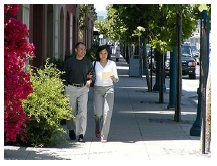
HSIP provides funding for safety projects aimed at reducing traffic fatalities and serious injuries. Although pedestrian safety projects are eligible for HSIP funding, it has sometimes been difficult for states and localities to justify spending HSIP funds on projects that will improve safety for these users because the related crashes are so infrequent—California's program is dedicated solely to pedestrians.
To develop the program, an investigation is ongoing that focuses on two data-related needs in support of a PSIP: methods for deploying and evaluating pedestrian safety improvement measures and broader understanding of data needs and collection approaches to support pedestrian safety projects. This is a 3-year project that will provide the foundation for the PSIP, which will be an ongoing pedestrian safety program at the California Department of Transportation (Caltrans). The program will focus on data collection and research to help guide the planning and implementation of pedestrian safety engineering, education, and enforcement projects. The outcome will be a PSIP – parallel in many respects to the HSIP – and administered in California by Caltrans. Anticipated benefits: dramatic increase in the resources available to governmental agencies and others in California for identifying the causes and prevention of pedestrian fatalities and injuries.
California also has a free Pedestrian Safety Assessment (PSA) Program through the University of California Berkeley's Institute of Transportation Studies, in which evaluators will review a city or county's pedestrian safety conditions, programs, and needs, and suggest new strategies to improve pedestrian safety. Any city or county agency in California can initiate a request for a PSA. After a thorough interview of local agency staff, a team of two pedestrian safety experts will visit the city or county for one day to conduct an evaluation using the comprehensive Guide for Conducting Pedestrian Safety Assessments to help the community achieve its objectives. Funding for this program is provided by a grant from the California Office of Traffic Safety, through the National Highway Traffic Safety Administration.
For more information, visit this website.
On November 30, 2011, FHWA hosted a webinar attended by almost 1,000 people entitled "Safety and Operations of Pedestrian Hybrid Beacon (HAWK) and Rectangular Rapid Flashing Beacon (RRFB)." This webinar reviewed the origin of the HAWK and RRFB, along with current installation and operational experiences. It also presented findings regarding motorist yielding and safety. Speakers were Richard Nassi, Pima Association of Governments; Kay Fitzpatrick, Texas Transportation Institute; and Ron Van Houten, Western Michigan University.
For those who missed it, the recording is available here. As mentioned on page 1, the pedestrian hybrid beacon is one of the countermeasures being promoted by FHWA. To receive information on future webinars, please use the e-subscription service provided here. Scroll down to "Pedestrian and Bicycle Safety" and select "subscribe" next to "Pedestrian Webinar."

Tamara Redmon, Pedestrian Safety Program Manager
Federal Highway Administration
1200 New Jersey Avenue SE
Room E71-303
Washington, DC 20590
Phone: 202-366-4077
Fax: 202-366-3222
E-mail: tamara.redmon@dot.gov
This Pedestrian Forum is available on the Web at http://safety.fhwa.dot.gov/ped_bike/pedforum/. To receive information on future newsletters, please use the e-subscription service provided on this site: http://safety.fhwa.dot.gov/esubscribe.cfm#ped. Scroll down to "Pedestrian and Bicycle Safety" and select "subscribe" next to "Pedestrian Forum."
Livable communities are a high priority of the U.S. Department of Transportation and the Obama Administration. A livable community is one that provides safe and convenient transportation choices to all citizens, whether it's by walking, bicycling, transit, or driving. Each year, unfortunately, pedestrian fatalities compose about 12 percent of all traffic fatalities, and there are approximately 4,000 pedestrian deaths. Another 70,000 pedestrians are injured in roadway crashes annually. The numbers are improving, but we still have a ways to go. Pedestrian safety improvements depend on an integrated approach that involves the four E's: Engineering, Enforcement, Education, and Emergency Services. The Pedestrian Forum highlights recent pedestrian safety activities related to the four E's that will help save lives.
